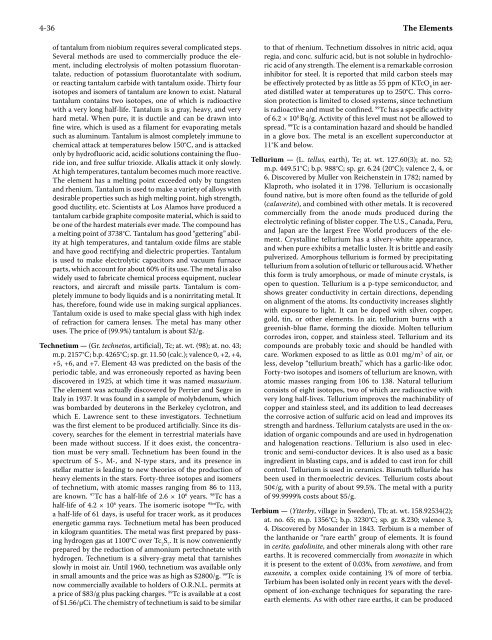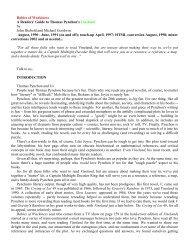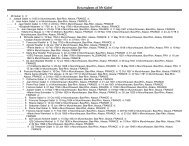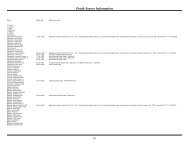CRC Handbook of Chemistry and Physics, 86th Edition
CRC Handbook of Chemistry and Physics, 86th Edition
CRC Handbook of Chemistry and Physics, 86th Edition
You also want an ePaper? Increase the reach of your titles
YUMPU automatically turns print PDFs into web optimized ePapers that Google loves.
4-36 The Elements<br />
<strong>of</strong> tantalum from niobium requires several complicated steps.<br />
Several methods are used to commercially produce the element,<br />
including electrolysis <strong>of</strong> molten potassium fluorotantalate,<br />
reduction <strong>of</strong> potassium fluorotantalate with sodium,<br />
or reacting tantalum carbide with tantalum oxide. Thirty four<br />
isotopes <strong>and</strong> isomers <strong>of</strong> tantalum are known to exist. Natural<br />
tantalum contains two isotopes, one <strong>of</strong> which is radioactive<br />
with a very long half-life. Tantalum is a gray, heavy, <strong>and</strong> very<br />
hard metal. When pure, it is ductile <strong>and</strong> can be drawn into<br />
fine wire, which is used as a filament for evaporating metals<br />
such as aluminum. Tantalum is almost completely immune to<br />
chemical attack at temperatures below 150°C, <strong>and</strong> is attacked<br />
only by hydr<strong>of</strong>luoric acid, acidic solutions containing the fluoride<br />
ion, <strong>and</strong> free sulfur trioxide. Alkalis attack it only slowly.<br />
At high temperatures, tantalum becomes much more reactive.<br />
The element has a melting point exceeded only by tungsten<br />
<strong>and</strong> rhenium. Tantalum is used to make a variety <strong>of</strong> alloys with<br />
desirable properties such as high melting point, high strength,<br />
good ductility, etc. Scientists at Los Alamos have produced a<br />
tantalum carbide graphite composite material, which is said to<br />
be one <strong>of</strong> the hardest materials ever made. The compound has<br />
a melting point <strong>of</strong> 3738°C. Tantalum has good “gettering” ability<br />
at high temperatures, <strong>and</strong> tantalum oxide films are stable<br />
<strong>and</strong> have good rectifying <strong>and</strong> dielectric properties. Tantalum<br />
is used to make electrolytic capacitors <strong>and</strong> vacuum furnace<br />
parts, which account for about 60% <strong>of</strong> its use. The metal is also<br />
widely used to fabricate chemical process equipment, nuclear<br />
reactors, <strong>and</strong> aircraft <strong>and</strong> missile parts. Tantalum is completely<br />
immune to body liquids <strong>and</strong> is a nonirritating metal. It<br />
has, therefore, found wide use in making surgical appliances.<br />
Tantalum oxide is used to make special glass with high index<br />
<strong>of</strong> refraction for camera lenses. The metal has many other<br />
uses. The price <strong>of</strong> (99.9%) tantalum is about $2/g.<br />
Technetium — (Gr. technetos, artificial), Tc; at. wt. (98); at. no. 43;<br />
m.p. 2157°C; b.p. 4265°C; sp. gr. 11.50 (calc.); valence 0, +2, +4,<br />
+5, +6, <strong>and</strong> +7. Element 43 was predicted on the basis <strong>of</strong> the<br />
periodic table, <strong>and</strong> was erroneously reported as having been<br />
discovered in 1925, at which time it was named masurium.<br />
The element was actually discovered by Perrier <strong>and</strong> Segre in<br />
Italy in 1937. It was found in a sample <strong>of</strong> molybdenum, which<br />
was bombarded by deuterons in the Berkeley cyclotron, <strong>and</strong><br />
which E. Lawrence sent to these investigators. Technetium<br />
was the first element to be produced artificially. Since its discovery,<br />
searches for the element in terrestrial materials have<br />
been made without success. If it does exist, the concentration<br />
must be very small. Technetium has been found in the<br />
spectrum <strong>of</strong> S-, M-, <strong>and</strong> N-type stars, <strong>and</strong> its presence in<br />
stellar matter is leading to new theories <strong>of</strong> the production <strong>of</strong><br />
heavy elements in the stars. Forty-three isotopes <strong>and</strong> isomers<br />
<strong>of</strong> technetium, with atomic masses ranging from 86 to 113,<br />
are known. 97 Tc has a half-life <strong>of</strong> 2.6 × 10 6 years. 98 Tc has a<br />
half-life <strong>of</strong> 4.2 × 10 6 years. The isomeric isotope 95m Tc, with<br />
a half-life <strong>of</strong> 61 days, is useful for tracer work, as it produces<br />
energetic gamma rays. Technetium metal has been produced<br />
in kilogram quantities. The metal was first prepared by passing<br />
hydrogen gas at 1100°C over Tc 2 S 7 . It is now conveniently<br />
prepared by the reduction <strong>of</strong> ammonium pertechnetate with<br />
hydrogen. Technetium is a silvery-gray metal that tarnishes<br />
slowly in moist air. Until 1960, technetium was available only<br />
in small amounts <strong>and</strong> the price was as high as $2800/g. 99 Tc is<br />
now commercially available to holders <strong>of</strong> O.R.N.L. permits at<br />
a price <strong>of</strong> $83/g plus packing charges. 99 Tc is available at a cost<br />
<strong>of</strong> $1.56/µCi. The chemistry <strong>of</strong> technetium is said to be similar<br />
to that <strong>of</strong> rhenium. Technetium dissolves in nitric acid, aqua<br />
regia, <strong>and</strong> conc. sulfuric acid, but is not soluble in hydrochloric<br />
acid <strong>of</strong> any strength. The element is a remarkable corrosion<br />
inhibitor for steel. It is reported that mild carbon steels may<br />
be effectively protected by as little as 55 ppm <strong>of</strong> KTcO 4 in aerated<br />
distilled water at temperatures up to 250°C. This corrosion<br />
protection is limited to closed systems, since technetium<br />
is radioactive <strong>and</strong> must be confined. 99 Tc has a specific activity<br />
<strong>of</strong> 6.2 × 10 8 Bq/g. Activity <strong>of</strong> this level must not be allowed to<br />
spread. 99 Tc is a contamination hazard <strong>and</strong> should be h<strong>and</strong>led<br />
in a glove box. The metal is an excellent superconductor at<br />
11°K <strong>and</strong> below.<br />
Tellurium — (L. tellus, earth), Te; at. wt. 127.60(3); at. no. 52;<br />
m.p. 449.51°C; b.p. 988°C; sp. gr. 6.24 (20°C); valence 2, 4, or<br />
6. Discovered by Muller von Reichenstein in 1782; named by<br />
Klaproth, who isolated it in 1798. Tellurium is occasionally<br />
found native, but is more <strong>of</strong>ten found as the telluride <strong>of</strong> gold<br />
(calaverite), <strong>and</strong> combined with other metals. It is recovered<br />
commercially from the anode muds produced during the<br />
electrolytic refining <strong>of</strong> blister copper. The U.S., Canada, Peru,<br />
<strong>and</strong> Japan are the largest Free World producers <strong>of</strong> the element.<br />
Crystalline tellurium has a silvery-white appearance,<br />
<strong>and</strong> when pure exhibits a metallic luster. It is brittle <strong>and</strong> easily<br />
pulverized. Amorphous tellurium is formed by precipitating<br />
tellurium from a solution <strong>of</strong> telluric or tellurous acid. Whether<br />
this form is truly amorphous, or made <strong>of</strong> minute crystals, is<br />
open to question. Tellurium is a p-type semiconductor, <strong>and</strong><br />
shows greater conductivity in certain directions, depending<br />
on alignment <strong>of</strong> the atoms. Its conductivity increases slightly<br />
with exposure to light. It can be doped with silver, copper,<br />
gold, tin, or other elements. In air, tellurium burns with a<br />
greenish-blue flame, forming the dioxide. Molten tellurium<br />
corrodes iron, copper, <strong>and</strong> stainless steel. Tellurium <strong>and</strong> its<br />
compounds are probably toxic <strong>and</strong> should be h<strong>and</strong>led with<br />
care. Workmen exposed to as little as 0.01 mg/m 3 <strong>of</strong> air, or<br />
less, develop “tellurium breath,” which has a garlic-like odor.<br />
Forty-two isotopes <strong>and</strong> isomers <strong>of</strong> tellurium are known, with<br />
atomic masses ranging from 106 to 138. Natural tellurium<br />
consists <strong>of</strong> eight isotopes, two <strong>of</strong> which are radioactive with<br />
very long half-lives. Tellurium improves the machinability <strong>of</strong><br />
copper <strong>and</strong> stainless steel, <strong>and</strong> its addition to lead decreases<br />
the corrosive action <strong>of</strong> sulfuric acid on lead <strong>and</strong> improves its<br />
strength <strong>and</strong> hardness. Tellurium catalysts are used in the oxidation<br />
<strong>of</strong> organic compounds <strong>and</strong> are used in hydrogenation<br />
<strong>and</strong> halogenation reactions. Tellurium is also used in electronic<br />
<strong>and</strong> semi-conductor devices. It is also used as a basic<br />
ingredient in blasting caps, <strong>and</strong> is added to cast iron for chill<br />
control. Tellurium is used in ceramics. Bismuth telluride has<br />
been used in thermoelectric devices. Tellurium costs about<br />
50¢/g, with a purity <strong>of</strong> about 99.5%. The metal with a purity<br />
<strong>of</strong> 99.9999% costs about $5/g.<br />
Terbium — (Ytterby, village in Sweden), Tb; at. wt. 158.92534(2);<br />
at. no. 65; m.p. 1356°C; b.p. 3230°C; sp. gr. 8.230; valence 3,<br />
4. Discovered by Mos<strong>and</strong>er in 1843. Terbium is a member <strong>of</strong><br />
the lanthanide or “rare earth” group <strong>of</strong> elements. It is found<br />
in cerite, gadolinite, <strong>and</strong> other minerals along with other rare<br />
earths. It is recovered commercially from monazite in which<br />
it is present to the extent <strong>of</strong> 0.03%, from xenotime, <strong>and</strong> from<br />
euxenite, a complex oxide containing 1% <strong>of</strong> more <strong>of</strong> terbia.<br />
Terbium has been isolated only in recent years with the development<br />
<strong>of</strong> ion-exchange techniques for separating the rareearth<br />
elements. As with other rare earths, it can be produced







